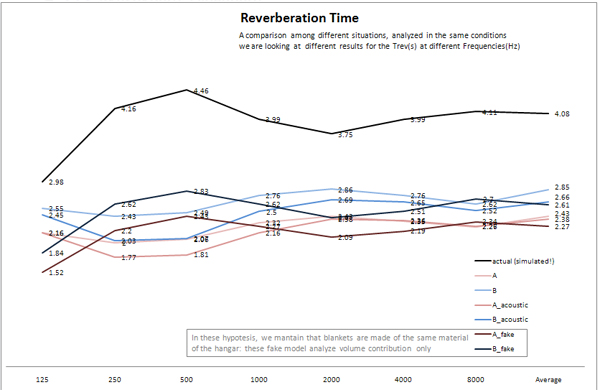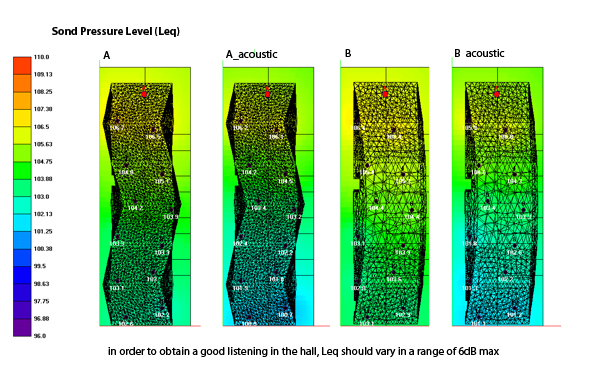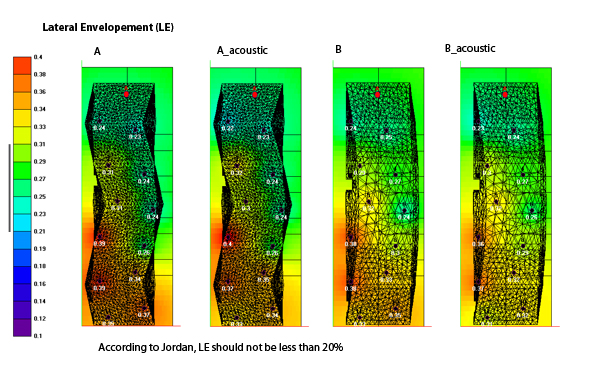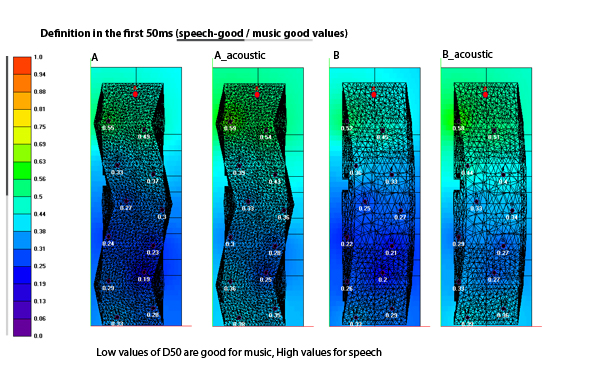Tesi master theses
Devoto fabrication partner
CNC: real experiences | case studies
Acoustics projects | form | analisys
Custom Families Revit
Data Production model to data
Visual Basic scripting for Revit
Barrisol project for a conferece hall
As I already said in previous posts,
the hangar renovation has to gain acoustic feautures. Therefore i set a first series of analysis whose results are the following.
1_purpose of the analisys
In the clients' intention, the hall has to be a conference hall or a sort of cinema. The analysis has a double acoustic purpose.
At first, it essential that the reverberation time loweres strongly. It is difficoult to quantify how much should it be lowered because we do not know its actual value (in order to make a good analisys we should need a session of in-situ measurements indeed).
On the other hand, other acoustic paramethers shall be good or at least acceptable (see AcAna_paramethers to take in account post).
2_limits of the analisys
Ramsete 2.5 is the software i used. This pyramid-tracing software offers a pretty good simulation, and its prediction can be excellent. But the origin data have to be good as well ("garbage in, garbage out").In our case we have two strong limits on the analisys, both of them due to a lack of origin data.
At first: we have no in-situ measurements of the current situation in the hangar. These measurements have a cost, which at present is not necessary and therefore not affordable by clients.
Moreover, Barrisol's acoustic data are not exactly what we need.
.jpg)
Indeed, Barrisol offers a series of acoustic values for simulation like this one. These values are not a-priori, because they are the result of measurements on 1:1 models. The further our model is far from those conditions, the worse the result will be given by simulations (see next paragraph).
Without these data are results not good? No, but they have to be interpretated as a general trend for the project's effect, not as real predictions.
3_about Barrisol
Barrisol is a blanket which can or cannot have acoustic features. This depends on what kind of barrisol we're buying Acoustic or Not. Moreover, its acoustic behaviour is strongly influenced by "what's behind it". Thus because it is a blanket, it has neither mass nor volume. It just defines a space but has no capability to absorbe energy from the sound wawe: it just transmit (and reflect) it, and therefore the most important element in the absorption process is the one receiving the amount of energy transmitted (a certain amount of energy is obviously trasmitted from the air to the blanket, whose vibration make it lose).

In picture we are looking at different absorbtion coefficient for the barrisol. We have to say now that, since project's budget is strictly limited, we cannot efford barrisol_acoustic. Moreover, we clearly see how close are the values for Barrisol Acoustic/not, in lack of rockwool case.

What influences the real absorption is therefore 1. material behind blanket (together with the pobbibility for the sound wave to reach this material: holes' percentage. Without holes this process works the same, but a far less) 2. distance between material and blanket. In this picture we see how do absorbed frequencies range variates as a result of the distance itself. This phonomenon exist on Not Acoustic Barrisol as weel, it it stronger indeed.
Moreover in our case The distance is 1. not constant and 2.in the order of bigness of the one of m, while in the second graph it is cm. Results are therefore strongly influenced by the fact that we are not using these data in a conventional way (even if the teorethical effect should be better for us, since the distance is not constant and therefore frequencies range variates point by point).
At present i've no better Barrisol data (i had asked. for....).
4_Experiment i set up
I set up a series of 7 simulations:
0_ actual condition (simulated! i tried and assigm materials in order to obtain a result similar to my perception of the actual condition)
.jpg)
A_drunk space B_quadratic space
(i assigned barrisol without rockwool values to blakets in the model_for me b + rockwool values are not acceptable at all)
.jpg)
A_with acoustic end B_with acoustic end
(halls are closed by an acoustic barrisol blanket+ rockwool_this is the usual situation for a conference hall)
A_FAKE B_FAKE
Since we cannot try the effective barrisol's impact on the project, i've tested the form only: realising fake models which has same form, but which i assigned hangar material (steel sheets) to. In my opinion, it is the form indeed (and not the material) which has the power to lower the reverberation time, since it create a new volume, smaller by far.
Simulations i've been making have a good level of precision, while they consider the first 100 reflections only. This condition is a good approximation.
NB:I've taken measurements in the inside-blankets volume only, at the height of the hear. Results are therefore referring to the acoustic space only (ramsete interpolates values: outer one are not good, in pictures)
I'm publishing now on results of these analisys.
5a_RESULTS: reverberation Time

We clearly notice what we expected: it's the form only, not the absorbtion power of each material (which is extremely poor in barrisol only case as well),lowering the Trev. The loss of sound tail is on the order of 40%, and this simulations are made in case of empty hall, therefore another contribution (around 15%) will by given by the audience. As said, we cannot consider numeric values, because of origin data but we mantain that the lowering given by either blanket or blks+acoustic-end is too small for a conference hall, whose Trev is close to 1s.
5b_RESULTS: hall's impulse response
Ramsete is not able to evaluate Initial Time Delay Gap, which is probably the most important paramether for the quality of the listening (in my recent posts, it quantifies what i callled haas effect).
 In this image we see that the hall response is good in every case. Since the variation is close to the extreme one (6db) and material's values are not totally reliable, it should be necessary an electronic system to strengthen the sound. I remember that we are in case of void hall: with people listening this need shall be more effective.
In this image we see that the hall response is good in every case. Since the variation is close to the extreme one (6db) and material's values are not totally reliable, it should be necessary an electronic system to strengthen the sound. I remember that we are in case of void hall: with people listening this need shall be more effective.

Lateral Envelopement, an important paramether giving the spatial impression of the audience, is everywhere acceptable, but not outstanding.
We mantain that the hall has a good acoustic response.
5c_RESULTS: hall's proprieties
These images show results for important paramethers which discriminates the use of an hall (music-speech). We have to say now that these values are extremely influenced by the bad origin data! and so these are nothing but an advice.
Values collected for Clarity in the forst 50ms show that the hall seem not to be this good for speech...

...while the values collected from the C80 show a good capability for music listening (Situation A_acoustic exceeds expectations).

Thus confirmed by Definition Values as weel.
In the end: the "drunk" solutions offer better performances for the music listening (because of its more irregular form, reflecting soung waves more randomly); both of them does not have at present features to become a good conference hall. Thus beacuse the absorbtion mechanism is linked to form and not material caratheristics. In order to make the hall become a conference hall, it shal be necessary
1)further measurements
2)further data
3)other system of sound absorption (when we listen to speech, we need to identify better -more clarity, more definition- each word, and each word has to decay soon, in order to make a speech comprehensible.While we listen to music, on the other end, most of the armony perception is given by the melting of different sounds: therefore we need an higher persistence of each sound, and a smaller clarity and definition).
commenti
MarcoMondello
14 Aprile, 2009 - 20:21
Collegamento permanente
STI
I forgot to publish results for the STI (speech transmission index) which measures the intelligibilty of the speech.
StefanoConverso
9 Luglio, 2009 - 15:59
Collegamento permanente
Zaha Hadid Architects' Chambers Music Hall - Manchester
Erik Verboon provided us with a great link:
here is the recently built project by Zaha Hadid Architects that employs an acoustic surface really similar to what we've been working on. The digital simulation is credited to Tony Hogg Design and Base Structures
The initial part of the design involved testing the baseline acoustic response of the gallery space and looking at how this could be enhanced by the installation. This included investigating how the finishes and shape of the room determined its reverberation time (a measure of how long it takes for sound to decay in a room), and caused unwanted flutter echoes from sound repeatedly reflecting back-and-forth between surfaces. The measurements also identified the level of ambient noise from external noise sources, such as road and air traffic, and from air conditioning systems within the building.
3D Model (Courtesy of Tony Hogg Design and Base Structures)
The selected gallery space is located towards the rear of the building, away from the noisy rumbling sound of Metrolink trams passing by the front. However, control of noise from the in-house air conditioning system to make it suitable for music was a challenge. The gallery has strict requirements for the regulation of air temperature and humidity to help preserve many of the precious works it houses. This meant it could not be turned off or reduced during performances. The importance of this was highlighted by the recent exhibition of 500 year old Leonardo da Vinci sketches in a connecting room to the new performance space. Control of noise from the air conditioning system was discussed with staff at Manchester Art Gallery and they were particularly helpful in carrying out works behind the scenes to help reduce noise intrusion to the new performance space.
3D Model (Courtesy of Tony Hogg Design and Base Structures)
For optimum conditions for chamber music it is important to ensure that the reverberation time is not too long as this blurs individual notes so music can lose its intricacy. Equally it should not be too short as this provides a lack of response for the performer and causes the music to sound overly dry. The designers therefore looked at achieving a reverberation time of 1.4 to 1.7 s at mid-frequencies (500-1000 Hz) with a higher reverberation at lower (bass) frequencies to provide a warm room response.
3D Model (Courtesy of Zaha Hadid Architects)
Measurements in the room indicated the existing ceiling and the large void behind it provided a significant amount of acoustic absorption. This influenced the choice of materials for the installation as the designers wanted to avoid adding too much additional sound absorptive material to ensure the acoustics did not become too dry. Zaha Hadid Architects therefore investigated use of different materials for the installation, including various fabrics, metals and plastics. These were developed as 3D CAD models by Zaha Hadid Architects and were then imported into acoustic modelling software by Sandy Brown Associates. This enabled the investigation of different finishes and sculptural shapes to enhance acoustic conditions around the stage and audience areas of the space.
3D Model (Courtesy of Zaha Hadid Architects)
The final installation uses a lightweight synthetic fabric (150 g/m2) supported on a rigid metal framework to provide the flowing sensual shape of the installation while minimising absorption. The shape of the frame and fabric acts to scatter sound reflections between parallel walls within the gallery to eliminate flutter echoes and provide a more even diffuse sound for audience members. Around the stage, specially shaped acrylic reflector panels have been carefully positioned and hidden within the fabric of the installation. These are designed to reflect sound with a short delay back towards the performer and out towards the audience to increase the clarity and strength of the music while maintaining the reverberant response of the room.
more information on BUSTLER
Thanks erik for providing the Link!
MarcoMondello
7 Ottobre, 2009 - 17:34
Collegamento permanente
CONTROSOFFITTI ACUSTICI - acoustic ceilings
Besides Zaha HAdid's concert hall in manchester (see comment below), here i publich a couple of projects focused on ceiling's acoustic treatment.
source: http://www.serero.com/projects/coupoles_acoustiques/
Design of an installation to be hang in villa medici, Roma-Serero Architects. Its form reflects soundwaves in order to enhance acoustic performances. Images in link clearly show a raytracing analisys, which can be made via Ecotect.
UNFORTUNATELY I DO NOT FIND PICTURES ANYMORE
for this sci-ARC acoustic ceiling installation, to be hang over a conference hall.
source: http://www.archinect.com/forum/threads_print.php?id=6798_0_42_0
here you find a nice discuss about this amazing project...i wonder if anybody could provide missing images